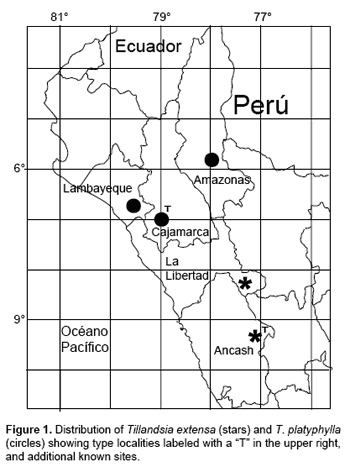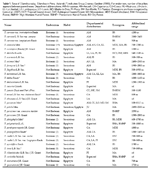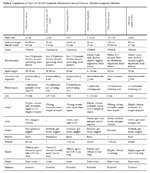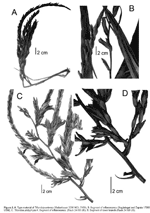Services on Demand
Journal
Article
Indicators
-
 Cited by SciELO
Cited by SciELO
Related links
-
 Similars in
SciELO
Similars in
SciELO  uBio
uBio
Share
Revista Peruana de Biología
On-line version ISSN 1727-9933
Rev. peru biol. vol.15 no.2 Lima 2008
TRABAJOS ORIGINALES
General overview of Tillandsia subgenus Tillandsia in Peru: the three-pinnate species and the case of two endemic species
Sinopsis de Tillandsia subgenus Tillandsia en el Peru: las especies tri-pinnadas y el caso de dos especies endémicas
Blanca León1, 2 and Abundio Sagástegui3
1 Museo de Historia Natural, Universidad nacional Mayor de San Marcos, Av. Arenales 1256, Apartado 14-0434, Lima-14, Perú.
2 Plant Resources Center, University of Texas at Austin, U.S.A. Email Blanca León: blanca.leon@mail.utexas.edu
3 Department of Botany, The Field Museum, Chicago, IL, USA.
Abstract
A recent collection of a specimen with three-pinnate inflorescence was the inspiration to evaluate Tillandsia subgenus Tillandsia taxa with three pinnate inflorescences for the Peruvian flora. Tillandsia extensa characteristics are clarified, confirming its distribution for northeastern Peru, and recognizing a specimen, previously considered being the second record for this species, as T. platyphylla.
Keywords: Bromeliaceae, Peru, Tillandsia subg. Tillandsia, T. extensa, T. platyphylla, new records.
Resumen
La recolección reciente de un ejemplar de inflorescencia tri-pinnada motivó la evaluación de los taxones con inflorescencias tri-pinnadas de Tillandsia subgénero Tillandsia para la flora peruana. Se aclara las características de T. extensa, confirmándose su distribución para el noreste del Perú y reconociéndose un ejemplar, previamente considerado como el segundo registro de la especie, como T. platyphylla.
Palabras clave: Bromeliaceae, Peru, Tillandsia subg. Tillandsia, T. extensa, T. platyphylla, nuevos registros.
Introduction
The largely American family Bromeliaceae combines large species richness, a high degree of endemicity, and a wide ecological amplitude (Ibisch et al., 1996; Benzing, 2000; Kessler, 2002). The Bromeliaceae is among the most species rich families in the Peruvian flora, with over 450 species in 19 genera (Brako and Zarucchi, 1993; Luther, 2000, 2002, 2003; Ulloa Ulloa et al., 2004). Almost half of the Peruvian Bromeliaceae species are restricted in distribution to the country (León et al., 2006a,b), most of which are known from only one locality. Three main genera, Pitcairnia, Puya and Tillandsia, include over half the number of taxa of this family for the Peruvian flora.
The genus Tillandsia was recognized by Smith and Dowson (1973) with seven subgenera (Allardtia, Anoplophlytum, Diaphoranthema, Phytarrhiza, Pseudalcantarea, Tillandsia and Pseudocatopsis) encompassing over 410 taxa, of which 255 in six subgenera were recorded for the Peruvian flora. Later studies, especially of Gardner (1986) have shown that the genus and its subgenera require new circumscription, and thus, for example, Spencer and Smith (1993) segregated all members of the subgenus Pseudocatopsis in the genus Racinaea. Additionally studies have also shown that the genus Tillandsia as circumscribed is polyphyletic (Barfuss et al., 2005).
The re-evaluation of the subgenus Tillandsia by Gardner (1986) included the examination and use of new floral characters, subdividing subgenus Tillandsia in seven groups on the basis especially of sepal shape, filament length and shape, and anther insertion. Gardner (1986) also stressed the close association of this subgenus with a group of Vriesea species that later were transferred by Grant (1993) to Tillandsia subg. Tillandsia. Today, this subgenus includes over 160 taxa of the 117 earlier recognized by Smith and Downs (1977).
A recent collection made in northern Peru of a specimen with a three-pinnate inflorescence prompted the evaluation of the Tillandsia mima group, and a re-examination of Rauhs (1973) understanding of T. extensa. Because of changes in the systematics of Tillandsia subgenus Tillandsia, we also present a general overview of this subgenus in Peru.
The subgenus Tillandsia and the Peruvian flora
This subgenus is recognized by its free, symmetrical sepals, broad petal blades and conspicuous, exserted stamens, exceeding the claw of the petals, and a style slender and longer than the ovary. Gardner (1986) included in this subgenus some species previously recognized within the subgenus Allardtia, and subdivided the subgenus in five groups, recognized mainly by filament length, shape, anther position and the open corolla throat.
Most Andean species are included in Gardners Groups II and III. A few, particularly for Peru, T. carnosa, T. ecarinata, T. extensa, T. ferreyrae, T. platyphylla and T. teres were considered incertae sedis, because she did not have fresh material to confirm their characters. For the case of Tillandsia ferreyrae, and T. teres cultivated specimens and photographs of floral and habit features are available (e.g. http://fcbs.org/pictures/Tillandsia.htm ), showing unequal filament length, petal apices slightly recurved and open throat, and for these reasons we include them within Gardners Group II. This group includes part of what Rauh considered as the mima group, a group of species with lax, mostly 3-pinnate inflorescences, and spikes with secund flowers.
The Peruvian flora comprises 28 taxa belonging in this subgenus; while another additional four species recorded in neighboring countries should be expected in the flora (Table 1). Sixteen taxa are considered restricted to Peru; all of which, with the exception of four, are known from northeastern Peru, mostly from the Marañón river basin that runs along the departments of Amazonas, Ancash-Huánuco, Cajamarca, and La Libertad. Most species are found in rocky slopes growing in crevices, rarely as epiphytes. Those endemic taxa are scarcely collected, 14 of them are known of less than 5 localities, and for those known from one locality all are found in xeric ecoregions, Desert Shrubland and Dry Forest or subxeric conditions in the Mesoandean mesic ecoregion (Table 1), demonstrating the need to emphasize the study of these mostly non-humid areas and the conservation status of their biota (León et al., 2006a).
Tillandsia extensa and the three-pinnate inflorescence species of Tillandsia
Three-pinnate inflorescences are known in the subgenus Tillandsia, which in Peru occur in six taxa, T. extensa, T. ferreyrae, T. hildae, T. mima var. chiletensis, T. platyphylla and T. propagulifera (Table1 and Table2). Although all these species have distichously arranged flowers, however, with the exception of T. ferreyrae, these flowers are twisted secund pendent. All three-pinnate taxa (Table 2) are characterized by having a red rachis that usually the color extends to branches and basal bracts of the spikes. These taxa are known from northern Peru on both sides of the Andes, growing as epiphytes or saxicolous in dry forest and other xeric environments in the Mesoandean and Desert shrubland areas.
Tillandsia extensa was described by Mez (1906) based on a specimen collected by Augusto Weberbauer (3986, holotype: B- 10 0243333-36; isotype: MOL-7489) on July 1903 in Masín, a locality in the Department of Ancash, at 2500 m, in the Puccha valley, a tributary of the upper Marañón river on the eastern Andean slopes (Figure 1, Figure 2A). This saxicolous species is characterized by its 3-4-pinnate, paniculate, red inflorescences, with spikes 40 cm long, red floral bracts, erect or sub erect, not imbricate, pedicellate flowers and sepals 3 mm connate. The type collection was the only reference material for this species, until Rauh (1973) reported its rediscovery based on his collection (Rauh 24168 HEID n.v., US) made in northwestern Peru, in the Saña basin between 600 and 700 m elevation. Based on these two isolated and disjunct records, this species was evaluated by León et al. (2006b) as Data Deficient.

Rauh (1973) reported his finding after sending a duplicate of his collection and photographs to Lyman B. Smith at US for verification. Rauh initially thought his specimen (Rauh 24168) to be a new species, and in his correspondence to Smith he proposed to name it after him. As noted by Rauh (1973), his collection was characterized by its 2-3 pinnate, paniculate inflorescences, with red axis, spikes 25 cm long, flowering bracts green at their base, and margins and apices red, sessile flowers and connate sepals 2-2,2 cm long. Smith appeared to have had for comparison only a photograph of the type at B, and this photograph shows a portion of the inflorescence broadly resembling Rauhs collection inflorescence. Rauh specimen 24168 was therefore identified as a second collection of T. extensa by Smith (1977).
A more recent collection made in August of 2002 in the Marañón valley was also a plant with a three-pinnate red inflorescence. This specimen (A. Sagástegui and M. Zapata 17093 HUT, USM) was made in the Dpto. La Libertad, Prov. Pataz, between: Huaylillas and Puente Chacas (08º12,1 S, 77º19,8 W), at 2400 m, growing on rocky steep slopes, and with a shrubland vegetation with columnar cacti, Furcraea andina Trel., Arnaldoa weberbaueri (Muschl.) Ferreyra, and a dominant endemic shrub, Gochnatia patazina Cabrera. This recent specimen has paniculate, 2 m long inflorescences (Fig. 2 B), proximal and medial spikes pedunculate, and slightly overlapping red floral bracts. Comparison of characters of those three-pinnate species in Peru (Table 2) and examination of herbaria specimens revealed that this specimen belong in T. extensa as originally described. This specimen also represents the second record for the species, within the Marañón basin, nearly 130 km apart from the original locality (Figure 1). It is probable that other populations might be found in similar habitat conditions along the basin. The presence of this and other endemic species within the reported area supports the conservation importance of the basin (e.g. Linares-Palomino, 2006).
Rauhs 24168 collection (Fig. 2 C-D) is a saxicolous plant with rosulate leaves, 60 cm long, 2 cm wide. Scape cylindric, compact, grayish, approximately 70 cm long; lower bracts imbricate, narrowly triangulate, acuminate. Inflorescence 1,6 m long, lax, 3-pinnate, axis red; spikes curved, descending, 25 cm long; floral bracts green, apices and margins red, oblong, acuminate, 2 cm long x 0,8 cm wide, imbricate by 1/2 of its total length; flowers erect, sessile, ca. 3 cm long, sepals light green, ecarinate, oblong, obtuse or acuminate, 2-2,2 cm long, petals dark violet, stamens exserted, filaments of different size, style exserted. In Table 2, a comparison of this material with Peruvian three-pinnate species reveals that although its leaves are narrower it shares many features of Tillandsia platyphylla Mez, and here is recognized as such.
Tillandsia platyphylla was also described by Mez (1906) of a Weberbauer collection (Weberbauer 3888, holotype: B 10 02434913, available on-line, see Röpert, 2000) made in July 1904, in northwestern Peru, in the Dept. Cajamarca, between San Miguel and San Pablo, ad 1700 m, growing among rocks, probably in the Jequetepeque basin (Fig. 1). This species was recorded by Smith and Downs (1973) from an additional locality, based on a Rauh collection (24572, HEID n.v., US) which was made in 1970, in northeastern Peru, Dept. of Amazonas, Prov. Bongará, near Ingenio (approx. 05°57 S, 78° W), at 800 m, in the Utcubamba river valley, a tributary of the Marañón.
Thus, this species is known from both sides of the Peruvian northern Andes.
Rauh 24168 represents the second record in the western range of T. platyphylla. Cultivated material exists (http://fcbs.org/pictures/Tillandsia.htm ) probably originating from Rauhs original collection, and a photograph of its flower supports its inclusion within Gardners II group. As is the case for species from dry Andean slopes, little is known about the sizes and conservation status of its populations (León et al. 2006a). León et al. (2006b) listed this species as Data Deficient; and although Rauhs record dates from the 1970s it provides, however, a glimpse that this long-lived species might have a wider distribution.
Acknowledgments
We thank Graciela Vilcapoma of Herbario Weberbauer (MOL) for giving us information and access to Weberbauers collection. Asunción Cano and María Isabel La Torre helped us with Tillandsia material at USM. Thanks to Debbie Bell, Vicki Funk, Linda Hollenberg, Greg McKee, Dan Nicholson and Harold Robinson of US for their help in discussing various taxonomic matters, historical accounts and for providing access to the US collection. We also thank Kenneth Young for comments on an earlier version of the manuscript. Jason Grant and Harry Luther provided insightful comments, suggestions and a thoroughly review of the manuscript.
Literature cited
Barfuss, M.H. J., R. Samuel, W. Till & T.F. Stuessy. 2005. Phylogenetic relationships in the subfamily Tillansioideae (Bromeliaceae) based on DNA sequence data from seven plastid regions. Amer. J. Bot. 92(2): 337351.
Benzing, D. H. 2000. The biology of the Bromeliads. 305 pp. Eureka, CA : Mad River Press Inc., 1980.
Brako, L. & J. L. Zarucchi, 1993. Catalogue of the flowering plants and gymnosperms of Peru. Monogr. Syst. Bot. Missouri Bot. Gard. 45: 11286.
Gardner, C.S. 1986. Preliminary classification of Tillandsia based on floral characters. Selbyana 9(1): 130-146.
Grant, J.R. 1993. True Tillandsias misplaced in Vriesea (Bromeliaceae: Tillandsioideae). Phytologia 75(2): 170 175.
Ibisch, P.L., A. Boegner, J. Nieder & W. Barthlott. 1996. How diverse are neotropical epiphytes? An analysis based on the Catalogue of the Flowering Plants and Gymnosperms of Peru. Ecotropica 2: 1328.
Kessler, M. 2002. Environmental patterns and ecological correlates of range size among Bromeliad communities of Andean forests in Bolivia. In: K.R Young, C. Ulloa Ulloa, J. Luteyn & S. Knapp, eds. Plant Evolution and Endemism in Andean South America. Bot. Rev. 68(1): 100127.
León, B., N. Pitman & J. Roque. 2006a. Introducción a las plantas endémicas del Perú. . In. B. León, J. Roque, C. Ulloa Ulloa, P.M. Jørgensen, N. Pitman & A. Cano, eds. Libro Rojo de las Plantas endémicas del Perú. Rev. peru. Biol., Edición Especial 13(2): 9s-22s.
León, B., A. Sagástegui, I. Sánchez V. & M. Zapata. 2006b. Bromeliaceae endémicas del Perú. In. B. León, J. Roque, C. Ulloa Ulloa, P.M. Jørgensen, N. Pitman & A. Cano, eds. Libro Rojo de las Plantas endémicas del Perú. Rev. peru. Biol., Edición Especial 13(2): 708s737s.
Linares-Palomino, R. 2006. Phytogeography and floristics of seasonally dry tropical forests in Peru. Pp. 257279. In: R. T. Pennington, G.P. Lewis & J.A. Ratter, eds. Neotropical Savannas and Seasonally Dry Forests. Plant diversity, biogeography, and conservation. Syst. Assoc. Spec. Vol. Ser. 69. CRC, Boca Raton.
Luther, H.E. 2000. Miscellaneous new taxa of Bromeliaceae (XV). Selbyana 21(1,2): 125–131.
Luther, H.E. 2002. Miscellaneous new taxa of Bromeliaceae (XVII). Selbyana 23(1): 46–56.
Luther, H.E. 2003. Miscellaneous new taxa of Bromeliaceae (XVI). Brittonia 54(4): 279–285.
Mez, C.1906. XI. Additamenta Monographica 1906. Repert. Spec. Nov. Regni Veg. 3: 33-45.
Rauh, W. 1973. Bromelienstudien. I. Neue und wenig bekannte Arten aus Peru. Akad. Wiss. Math.-Naturwiss. Kl., Trop. Subtrop. Pflanzenwelt. 3(1): 167–203.
Rauh, W. 1977. Bromelienstudien I. Neue und wenig bekannte Arten aus Peru und anderen Ländern (7. Mitteilung). Trop. Subtrop. Pflanzenwelt. 21(7): 5–48.
Röpert, D. (ed.). 2000-(continuously updated). Digital specimen images at the Herbarium Berolinense. Published on the Internet http://ww2.bgbm.org/herbarium/default.cfm) [Access: 21/ 02/2008]
Smith, L.B. & R. J. Downs, 1977. Bromeliaceae, Flora Neotropica Monograph 14(2): 6631492.
Spencer, M.A. & L.B. Smith. 1993. Racinaea, a new genus of Bromeliaceae. Phytologia 74(2): 151160.
Ulloa Ulloa, C., J. Zarucchi & B. León. 2004. Diez años de adiciones a la flora del Perú: 1993--2003. Arnaldoa Número Especial: 7242.
__________________
Presentado: 21/02/2008
Aceptado: 18/03/2008
















